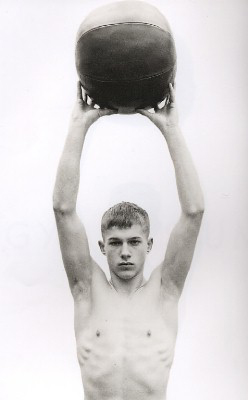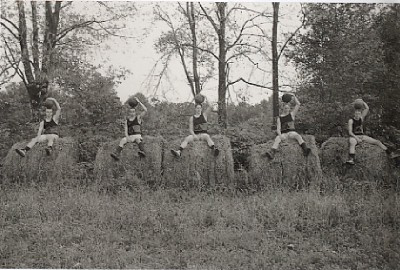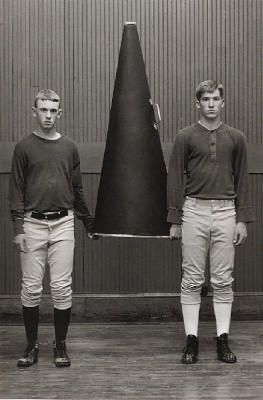|
|||||||||||
|
Luke Smalley, “Gymnasium,” Wessel + O’Connor Gallery,
242 W. 26th St., New York, October 12-November 25, 2001
Luke Smalley is a Pennsylvania-based photographer whose subject
in his first solo exhibition and book are male high school athletes.
Smalley’s work is not the stuff of celebratory small town photojournalism
but rather an elaborately crafted and posed body of photos whose
participants, though real athletes (Smalley found them in various
Pennsylvania and Ohio high schools), act out a series of scenarios
using antique athletic equipment, much of it fashioned by Smalley
himself. The premise of the project is outlined in an uncredited
text at the beginning of the book version of Gymnasium, which extols
the idealized athletic boy at the expense of angst-ridden, academics-obsessed
adolescents who spend far too many hours brooding in their rooms.
“It is the boys who have snap and vim and energy, who have
a plentiful supply of ‘ginger,’” Smalley quotes (or
writes himself, in which case his text is a masterful recreation
of what might be called the Boy Scout Handbook aesthetic), “that
accomplish results of importance...The boy who wants to be strong
and rugged, who wishes to grow up into a superb, manly man, and
who uses his surplus energies and wholesome games and in a temperate
amount of study, will avoid without the slightest effort all that
is evil.”1
There are, of course, various traditions which can be invoked as
a way of framing Smalley’s work. The artifice on display here,
that of consciously relocating the subject in time and space, is
deeply embedded in photographic history. Unlikely as it may seem,
the true progenitors of Smalley’s work are the constructed
tableaux of nineteenth century photographers like Oscar Rejlander
and Henry Peach Robinson, perhaps even the allegorical portraits
Julia Margaret Cameron made of friends and family in the 1860s and
70s.2 One can also cite the more contemporary works of
Philip-Lorca DiCorcia and Cindy Sherman, two photographers (among
many) who take as the subject of their photography questions of
constructed identity and the ambiguous nature of photographic “truth.”3
More obvious even to the casual observer is Smalley’s debt
to a longstanding and diverse tradition of homoerotic subject matter
in photography. In this sense, the photos in Gymnasium are derived
from Wilhelm von Gloeden and Fred Holland Day’s early twentieth
century work and updated by way of Bruce Weber, though divested
of nudity and any overt sensuality along the way.4 The
youngest subject in Gymnasium, a buzz-cut boy wearing black trunks
and nothing else, could in fact have stepped from the frames of
“Broken Noses,” Weber’s 1987 cinematic gaze at a
boys’ boxing club in the Pacific Northwest. For all Weber’s
contrivance, though, for all the hair gel and moody lighting and
naked romping with dogs and each other, he allows his subjects a
naturalism that Smalley’s more narrowly defined athletes do
not have. We know nothing about them outside of their fabricated
contexts; they are unnamed, the photos themselves untitled, and
the boys have been stripped of everything but their bodies, their
poses, their unmediated gaze at the lens.
Gymnasium is boy after boy, crouching, lifting, hurling, running,
rowing, lunging, in pairs, in trios, alone. These boys are physical
paradigms all, embodiments of body, for the most part unsmiling,
willing participants in the recording of body-glory. There are no
depictions of athletes of color and a tacit nod to contemporary
gay aesthetics of beauty (no body hair to be seen on Smalley’s
athletes, no bad complexions, no one fat or misshapen or conventionally
ugly). Smalley seems most interested in documenting a nostalgic
history of the primal urge boys have to play games, to test themselves,
to measure athletic prowess, to achieve athletic success. There
isn’t much about the thrill of victory here, though the emotions
of defeat are also all but absent. In one photo, a boy sits alone
on a throne-like chair, wearing white shorts, a pair of antique
cleats and a banner across his perfect bare chest that proclaims
“FIRST.” The boy’s face is blank; he sits like a
prince unimpressed or even unaware of his kingdom. In another photo,
a quintet of boys sit on enormous rolled hay bales, balancing basketballs
on their heads with their left hands, their right hands dangling
between splayed legs. They do this not because they reenact some
forgotten ritual of gymnasium culture but because Smalley thought
this would make an interesting composition. (In a companion photo,
the same quintet stands on the hay bales and now balances the balls
on their heads with their right hands.) The expressions on the boys’
faces, though hard to read from a distance, appear as uninflected
as the seated boy with his banner. They are plainly not thinking
about artifice and the construction of nostalgia and the homoerotic
gaze; they are doing what Smalley told them to do, and that seems
enough.
The unasked question in Gymnasium is not necessarily one about the artist’s intention (which seems clear enough) or about the propriety of studying and documenting adolescent sexuality (however peripheral this is in Smalley’s photos). It is instead a question about fabricated identity and possibly fabricated desire. Smalley’s work taps into the twin grails of contemporary advertising culture, youth and beauty (and the longing for both). He aestheticizes his subjects, strips them of sweat, grime, blood and the smells of locker room and playing field, strips them as well of the pervasive sports-based and gym-class cruelty which presumably dominates the adolescent memories of most non-athletes. Smalley’s athletes are purified, in other words, in form but also in sensibility. This further distances us (and them) from the complicated contemporary reality of sports, from the troubling issues of adolescent sexual allure. These photos, because of the obvious inaccessibility of their subjects, create a kind of illicit (and unfulfillable) longing, an impossible desire which is paradoxically permitted only in the act of looking at the photos themselves. Are any of his high school athletes gay? Are any of them aware that the majority of the viewing audience for Smalley’s photos are likely to be gay men? Would they care if they knew? In the orderly and nostalgic world of Gymnasium, none of the answers seem to matter.
|
|||||||||||



